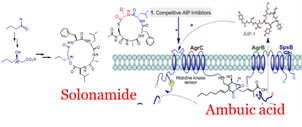Medicinal Chemistry
Prof Barrie Kellam: Design/synthesis of bioactive/fluorescently labelled small molecules
Dr Michael Stocks: Rational and Fragment approaches to drug discovery. Targeted drug delivery
Dr Weng Chan: Peptide synthesis, antimicrobials, antibiotic discovery
Dr Shailesh Mistry: Design/synthesis of G-protein coupled receptor (GPCR) ligands
The interests of this group are in the application of synthetic organic and medicinal chemistry to generate ligands for a broad range of biological targets, key for the treatment or understanding of a number of diseases. Research areas fall into two main themes:
- Drug discovery – identifying new chemical starting points, or optimising the physicochemical and biological properties of existing molecules, with a view to the development of therapies for areas of unmet medical need.
- Chemical biology – the design and development of molecules in pursuit of improved understanding of the structure or function of biological targets of interest.
The group brings together a range of expertise, and employs a number of techniques, including synthetic organic chemistry, compound purification and the use of a range of analytical techniques (HRMS, LCMS, HPLC, NMR, IR, optical rotation) to confirm compound structure, solid phase peptide synthesis, homology model generation and computational molecular docking studies. In addition, the group houses one of the few managed chemical compound collection (MCCC) facilities within an academic environment. With the capacity for 80,000 compounds, this facility provides a platform from which to screen for hits to initiate drug discovery campaigns.
We have extensive collaborative networks within the University and with industrial and academic partners within the UK and internationally, which have led to the award of substantial research funding. Current projects span a broad range from:
- Antibacterial drug discovery for Gram-positive (eg Staphylococcus aureus) and Gram-negative (eg Pseudomonas aeruginosa) pathogens
- Use of fluorescence correlation spectroscopy to study GPCR oligomerisation and allosterism in membrane micro domains of single living cells
- Therapies for neglected tropical diseases (Leishmania spp, Trypanosoma cruzi)
- The development of orthosteric/allosteric ligands for a range of GPCRs (b-adrenoceptors, adenosine, chemokine, histamine, dopamine)
- Targeting of non-GPCR proteins (platelet receptors, kinases such as PI3K)
- The use of pro-drugs for targeted drug delivery


